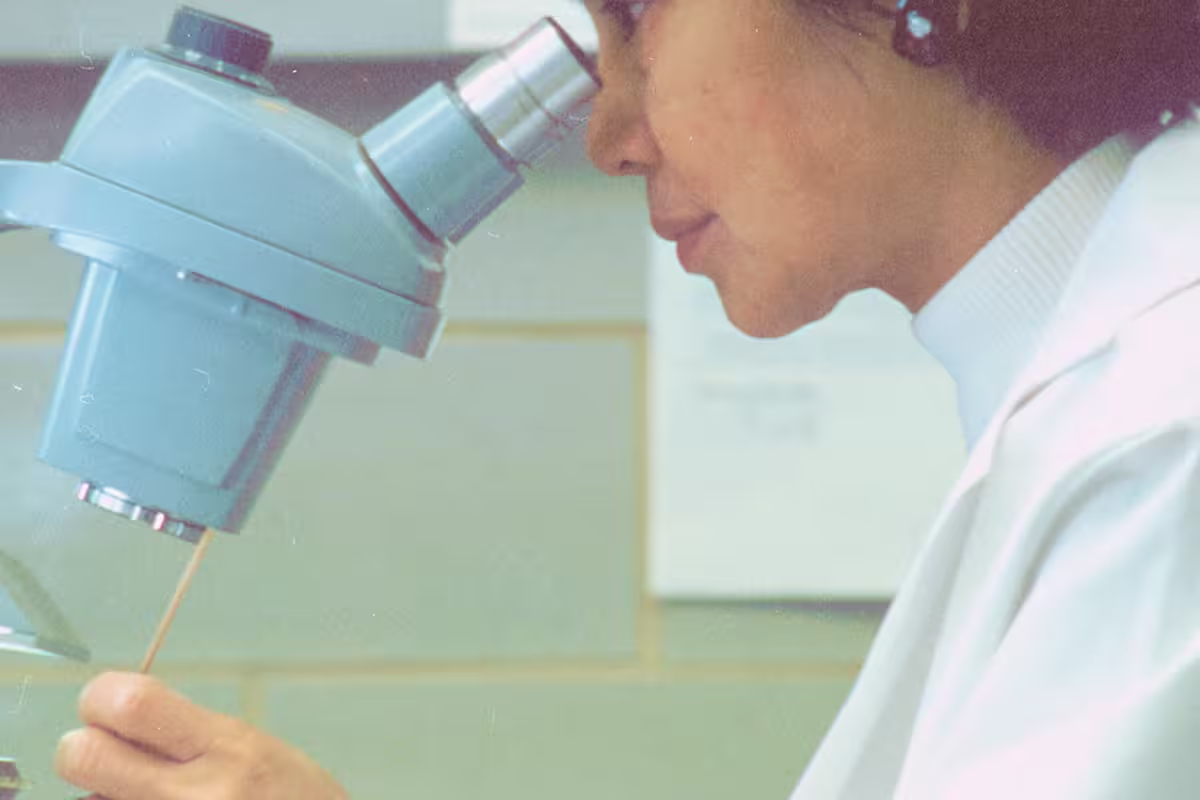

What Is BV? Understanding Bacterial Vaginosis
Learn all about bacterial vaginosis (BV), including its causes, symptoms, treatments, and how to test for BV so you can manage BV more effectively.
Words by Olivia Cassano
Scientifically edited by Dr. Krystal Thomas-White, PhD
Medically reviewed by Dr. Kate Stewart, MD
Bacterial vaginosis (BV) is a common condition that affects many women, yet it often remains misunderstood or misdiagnosed. If you've ever experienced unusual discharge or a fishy smell and wondered what might be causing it, you're not alone.
In this ultimate guide to BV, we'll break down everything you need to know — from its causes and symptoms to treatment options and prevention tips.
What is BV?
Bacterial vaginosis is a vaginal infection caused by the overgrowth of bad bacteria in your vaginal microbiome.
A healthy vaginal microbiome is made up mostly of healthy bacteria such as lactobacilli, a lactic-acid-producing bacteria that fight pathogens and keep infections away.
When lactobacilli dominance is disrupted, your vaginal pH can go up, allowing other types of bacteria to grow and cause an imbalance (known in medicine as dysbiosis). This causes symptoms like discomfort, itching, and unusual vaginal discharge.
If you’re dealing with bacterial vaginosis, you’re far from alone. According to the Centers for Disease Control (CDC), bacterial vaginosis is the most common vaginal condition in women ages 15-44. and almost 30% of people with vaginas get bacterial vaginosis each year.
BV symptoms
Bacterial vaginosis doesn't always have symptoms, so many people — up to 84% — don't even know they have it. Sometimes symptoms are so mild that you don't notice them.
The main symptom of BV is increased vaginal discharge that is watery and has a strong fishy smell that is more noticeable after having sex. The discharge may be white, gray, or greenish.
Sometimes, you may have a little itching or burning when you pee, but most people don't have noticeable irritation or discomfort.
Many vaginal infections have similar symptoms, so although they can sound the alarm and let you know that something’s not quite right, symptoms alone aren’t always enough for a diagnosis. Most of us aren’t very good at diagnosing ourselves. One study found that self-diagnoses of BV were right only 56% of the time.

Recurrent symptoms? Get Evvy's at-home vaginal microbiome test, designed by leading OB-GYNs.
What causes BV?
Bacterial vaginosis happens when the natural balance of your vaginal microbiome is thrown out of whack and anaerobic bacteria take over.
Research shows that certain activities or events may increase or decrease your risk of BV. Some of these risk factors include:
- Sex (specifically, with multiple sex partners or a new sex partner)
- Hormonal fluctuations (e.g., birth control, pregnancy, and menopause)
- Your period
- Smoking cigarettes
- Stress
- Douching and using vaginal hygiene products.
However, researchers still aren't sure what the exact cause of BV is, or how some women get it.
If you’re shocked that this is the best available answer for a condition that affects one in three women, you’re not alone. This is why Evvy exists! The vaginal microbiome and bacterial vaginosis are massively understudied, and it’s time women and people with vaginas got the research and care they deserve.
The connection between BV and sex
BV has long been considered not a sexually transmitted infection (STI), and you can indeed develop BV without being sexually active. Because it’s defined as an imbalance in the vaginal microbiome, the traditional view has been that you can’t “catch” BV from a partner. However, this understanding is starting to shift.
New research, including a notable study published in The New England Journal of Medicine (NJEM), suggests that BV may be sexually transmitted. Scientists have found BV-associated bacteria in the male urethra and on penile skin, and women with regular sexual partners are twice as likely to experience BV recurrence. Even more compelling, the composition of a male partner’s microbiome may help predict a woman’s risk of BV — highlighting that BV might not just be a vaginal issue, but part of a shared bacterial environment between partners.
There’s still no official consensus, but the tides are changing as evidence mounts that BV could be sexually transmissible after all.
Hormones and BV
Hormones play a role in the composition of the vaginal microbiome. Estrogen, in particular, is an important variable in the health of your lactobacilli, the bacteria that create a lactic acid-dominant environment in the vagina. Anything that changes estrogen levels can affect the vaginal microbiome.
This means that it’s important to pay extra attention to your vaginal microbiome anytime your hormones fluctuate, starting with:
- Your menstrual cycle
- Becoming pregnant
- Going through menopause
- Going on or changing birth control methods.
What happens if BV is left untreated?
The bacteria present in your vaginal microbiome influence the risk of a variety of other health issues, and untreated BV increases your risk of serious complications, including:
- STIs like chlamydia, gonorrhea, trichomoniasis, herpes, HPV, and HIV
- Pelvic inflammatory disease (PID)
- Fertility issues and failed in-vitro fertilization (IVF)
- Pregnancy complications like miscarriage, preterm birth, low birth weight, and preeclampsia
- Gynecological cancers such as ovarian, cervical, or endometrial cancer
- Cervicitis
- Toxic shock syndrome (TSS)
What is the difference between BV and a yeast infection?
Bacterial vaginosis is not the same thing as having a yeast infection, which is caused by candida (yeast). The main underlying difference is that yeast infections are caused by an overgrowth of Candida (a type of fungus), while bacterial vaginosis is caused by an overgrowth of a variety of bacteria like Gardnerella.
Though the symptoms in these two vaginal infections may overlap, yeast infections are typically characterized by a specific type of vaginal discharge (often compared to cottage cheese) and itchiness, while bacterial vaginosis is mostly associated with a fishy odor and thin white or gray vaginal discharge.
How is BV diagnosed?
The world of vaginal diagnostics is complicated, but there are two traditional ways to diagnose bacterial vaginosis. The first is symptomatically, based on something called the Amsel criteria. An Amsel criteria diagnosis is when you have three of the four following symptoms:
- white discharge
- clue cells
- a pH over 4.5
- a fishy odor.
A slightly more specific way to diagnose BV is with a Nugent score. Using the Nugent score, a vaginal smear is examined under a microscope for three bacteria morphotypes: Lactobacillus, Gardnerella, and curved gram rods.
A score is then created based on how many of each type have been counted, essentially looking for low, intermediate, or high diversity of bacteria in the sample. A score under four is diagnosed as healthy, 4-7 is intermediate, and 7-10 is considered high diversity, aka, BV.
You may have noticed that “high diversity” isn’t a very specific diagnosis — and you’re right. Unfortunately, current diagnostic measures don’t tell you much about what other bacteria are present or any other relevant information about how they’re interacting in your vaginal microbiome.
This is why we’ve created an at-home vaginal microbiome test, so you can understand all the bacteria present in your microbiome. Though it’s not a diagnostic test and shouldn’t replace your doctor's advice, it can help you uncover what strains are present and in what capacity to understand how they may contribute to any symptoms.
Where to get a BV test
You can order BV tests online, but Evvy’s Vaginal Health Test stands out by using the most comprehensive metagenomic sequencing technology available. It delivers physician-reviewed results and is processed in a CLIA, CLEP, and CAP-certified lab. The test can be taken from the comfort of your own home, with results delivered in just a few days. If BV-causing bacteria are detected, eligible users can access a personalized, prescription treatment program developed by a licensed provider. Our precision care platform uses your test results and health history to create a treatment plan tailored specifically to you.
How to treat BV
You can treat bacterial vaginosis with antibiotics prescribed by a doctor. Commonly used antibiotics include clindamycin and metronidazole, as well as alternatives such as tinidazole or secnidazole.
Unfortunately, these are not great solutions for treating bacterial vaginosis for good. While antibiotics clear up to 85% of bacterial vaginosis cases within a month, for over half of these patients, the infection will return within six months. Some studies show recurrence rates as high as 80%, three months after “effective treatment.” Doesn’t sound so effective to us!
It’s important to note that each antibiotic works better on some strains of bacteria compared to others, and certain ones spare the protective bacteria while others do not. When battling recurrent infections, knowing what specific bacteria are in your microbiome may be useful data for selecting an antibiotic.
We hope that further research into the vaginal microbiome can create an opportunity for more precise and effective treatments in the future. In the meantime, our Evvy Experts can help provide insights based on your microbiome to share with your medical provider.
How to test for BV
BV testing typically involves a healthcare provider performing a physical exam and collecting a sample of vaginal discharge. The sample is analyzed under a microscope to check for harmful bacteria linked to BV.
You can test for BV-causing bacteria using Evvy's Vaginal Health Test. It works just like a test you'd do in a doctor's office, but from the comfort of your own home. All you have to do is order a test, collect a vaginal swab sample, and send it to our lab in the prepaid mailer provided. The whole process takes five minutes and you'll receive your results back in a couple of days.
Evvy uses advanced metagenomic sequencing to detect and quantify the presence of specific bacteria, including those associated with BV, such as Gardnerella vaginalis, Prevotella spp., and Atopobium vaginae. The results provide a detailed breakdown of the vaginal microbiome, helping identify imbalances and offering actionable insights for personalized care. Eligible users will also have access to custom prescription treatment developed by a healthcare provider.
Why does my BV keep coming back?
Recurrent bacterial vaginosis is pretty common because it tends to resist treatment or come back after successfully treating it.
One potential reason why your BV is being stubborn is that a biofilm has formed in your vaginal microbiome. Bacteria are always trying to survive (who isn't) and sometimes they form what's called a biofilm. Biofilms are bacteria-made structures that protect the bacteria living inside them. Unfortunately, bacteria in a biofilm are harder to kill, making treatments like antibiotics less effective. This could be why BV has a high recurrence rate, but we're still learning about the exact role that biofilm plays in BV.
One way to help prevent a BV recurrence is to take a probiotic with helpful strains of vaginal bacteria regularly. This ensures that protective bacteria are always being introduced to strengthen your natural defense against pathogens, even if you’re taking antibiotics.
Aside from medication, there are some everyday behaviors you can do to prevent bacterial vaginosis from coming back:
- Avoid douching and feminine hygiene products (like scented soaps or vaginal deodorants). Douching upsets the normal balance of bacteria in your vagina.
- Wipe front to back after going to the toilet.
- Change your period products within the proper time frame.
- Choose underwear that is loose-fitting, lightweight, breathable, and made from a natural fabric, and change it often.
- Practice safe sex and use condoms or dental dams (yes, even during oral sex).
- Cover sex toys with a condom during partnered sex, and wash them with unscented soap/water after each use.
- Quit smoking.
FAQ
What causes you to have BV?
BV happens when the balance of bacteria in the vagina is off, allowing bad bacteria to outnumber the helpful ones. This can be caused by a few things, like having new or multiple sexual partners, douching, hormonal changes (during your period, pregnancy, or menopause), using intrauterine devices (IUDs), taking antibiotics, using scented vaginal products, and smoking. These factors mess with the natural bacteria in the vagina and increase the chance of getting BV. Knowing about and avoiding these triggers can help you maintain a healthy balance and avoid BV.
Is BV a form of STD?
BV isn’t officially classified as a sexually transmitted disease (STD), but emerging research suggests it can be sexually transmitted. While BV has traditionally been seen as a vaginal imbalance caused by factors like douching, hormonal changes, or certain products, studies now show that sexual activity — especially with new or multiple partners — can play a direct role in its transmission. So, although it’s not labeled a typical STD, there’s growing evidence that BV can be passed between partners, making sexual behavior an important factor in its development and recurrence.
Can you get BV without having sex?
Yes, you can get bacterial vaginosis even if you're not sexually active. Although it can be transmitted sexually, it’s not the only way to develop BV. Your period, smoking cigarettes, and using douches can all increase your risk of developing bacterial vaginosis.
Where do I go to get tested for BV?
You can get tested for BV by visiting your healthcare provider, who can perform a pelvic exam and send a sample to a lab. If you prefer a more convenient option, you can order Evvy’s Vaginal Health Test online. It’s an at-home test that detects BV-causing bacteria using advanced metagenomic sequencing. You collect your sample in the comfort of your own home and receive results within a few days. If BV bacteria are detected, eligible users can also access a personalized prescription treatment program through Evvy’s precision care platform.
Will BV go away on its own?
Sometimes, bacterial vaginosis can go away on its own. It often doesn’t cause symptoms so your immune system might get rid of it before you even notice. However, it’s best to see your healthcare provider if you’re experiencing bacterial vaginosis symptoms. Untreated BV is linked to a higher risk of contracting sexually transmitted infections, developing pelvic inflammatory disease, and even infertility.
Is BV a yeast infection?
No, bacterial vaginosis and yeast infections aren't the same. BV happens when there's a balance issue in vaginal bacteria, causing a fishy odor and thin, gray discharge, while yeast infections are due to an overgrowth of Candida fungus, resulting in thick, white discharge, itching, and burning. BV is commonly treated with antibiotics, while antifungal medications usually treat yeast infections. Knowing the differences between these conditions is important for the right diagnosis and treatment.
Can men get BV?
Only people with vaginas can develop BV because by definition it is an imbalance in the vaginal microbiome. However, male genitalia can harbor pathogens that disrupt the vaginal microbiome.





